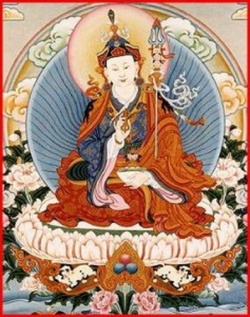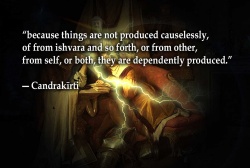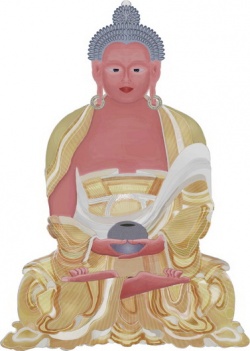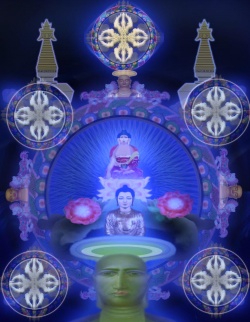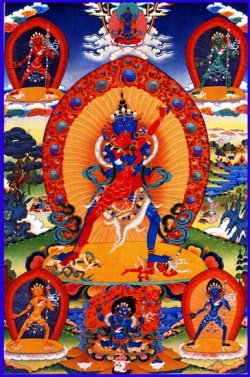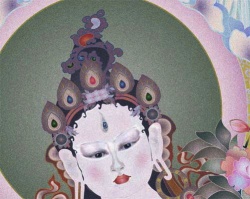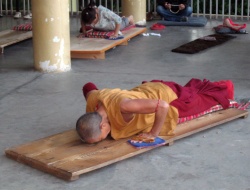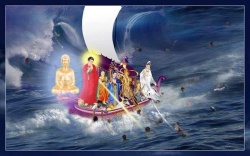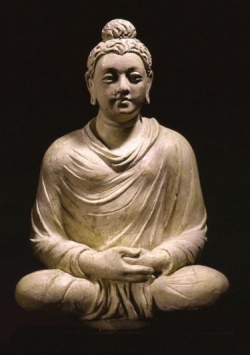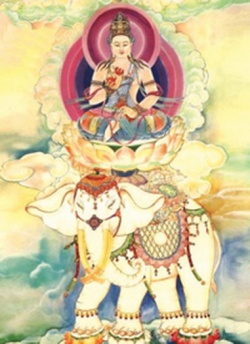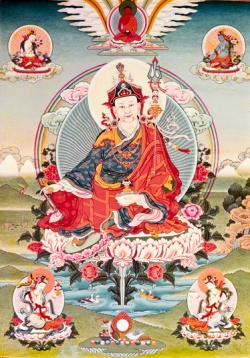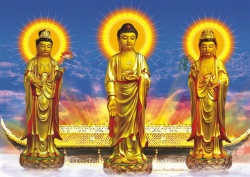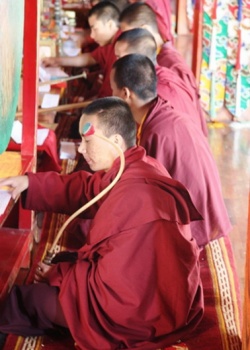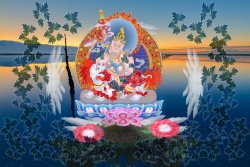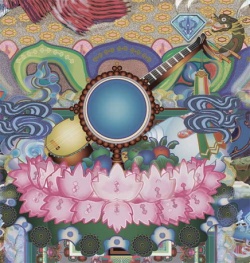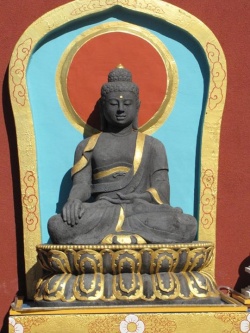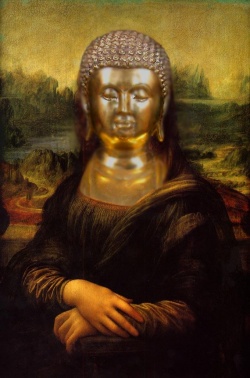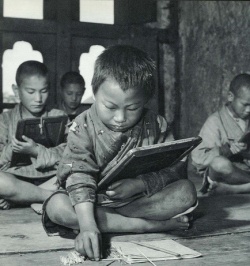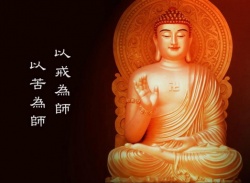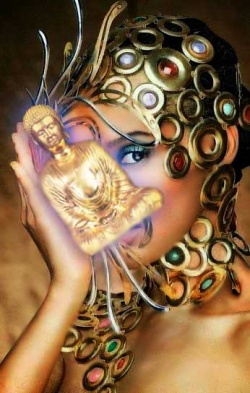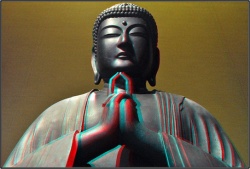Cittas
The World
Cittas can be classified as mundane, lokiya, and supramundane, lokuttara.
First of all we should understand the meaning of the world, loka, according to the discipline of the ariyan, as the Buddha explained in the “Kindred Sayings”( IV, Kindred Sayings on Sense, Second Fifty, Ch IV, § 84, Transitory). We read:
Then the venerable Ånanda came to see the Exalted One... Seated at one side the venerable Ånanda said to the Exalted One:
“ ‘The world! The world!’ is the saying, lord. Pray, how far, lord, does this saying go?”
“What is transitory by nature, Ånanda, is called ‘the world’ in the ariyan discipline.
And what, Ånanda, is transitory by nature?
The eye, Ånanda, is transitory by nature, visible object is transitory by nature, seeing-consciousness is transitory by nature, eye-contact is transitory by nature, pleasant feeling, unpleasant feeling or indifferent feeling arising owing to eye-contact, that also is transitory by nature.
(The same is said with regard to the other doorways.)
What is thus transitory, Ånanda, is called ‘the world’ in the ariyan discipline.”
For the ariyan, the person who has attained enlightenment, the transitoriness of realities is natural, but this is not so for the person who does not realize yet the arising and falling away of realities.
Someone cannot become an ariyan if he does not see the arising and falling away of the realities which appear.
The Buddha said to Ånanda that whatever is transitory by nature is the world in the ariyan discipline. The world is everything which arises and falls away.
The dhamma which does not arise and fall away is not the world; it is distinct from the world, supramundane, lokuttara.
This is nibbåna.
We can classify cittas as lokiya and lokuttara.
The citta which does not clearly realize the characteristic of nibbåna, thus, which does not have nibbåna as object, is mundane, lokiya citta.
The citta which has nibbåna as object and eradicates defilements is the path-consciousness or magga-citta, and the citta which has nibbåna as object after defilements have been eradicated is the fruition-consciousness or phala-citta, immediately succeeding the magga-citta; both types of citta are supramundane, lokuttara cittas.
One should develop lokiya paññå which realizes the characteristics of nåma and rúpa in order to become an ariyan.
Lokiya paññå is not technical knowledge or such knowledge as one needs to have in science.
Lokiya paññå in Buddhism is no other knowledge but the understanding of the characteristics of nåma and rúpa.
Lokiya paññå knows the characteristics of the “world”, namely, the realities which appear through the eyes, the ears, the nose, the tongue, the bodysense and the mind-door.
It knows the realities other than nibbåna.
There are four magga-cittas and these are the lokuttara kusala cittas of the four stages of enlightenment, which have nibbåna as object while they eradicate defilements in accordance with these stages.
There are four phala-cittas and these are the lokuttara vipåkacittas which have nibbåna as object when the defilements have been eradicated in accordance with the stages of enlightenment.
All other types of citta are lokiya ittas.
There are four pairs of lokuttara cittas, namely the lokuttara kusala citta and the lokuttara vipåkacitta of the sotåpanna, the streamwinner, of the sakadågåmí, the once-returner, of the anågåmí, the non-returner and of the arahat:
sotåpatti magga-citta sotåpatti phala-citta
sakadågåmí magga-citta sakadågåmí phala-citta
anågåmí magga-citta anågåmí phala-citta
arahatta magga-citta arahatta phala-citta
When the magga-citta of the sotåpanna arises it performs the function of eradicating defilements while it has nibbåna as object, and then it falls away. It is succeeded immediately by the phala-citta of the sotåpanna.
This citta also has nibbåna as object and when it arises the defilements have already been eradicated by the magga-citta of that stage.
The sotapatti magga-citta is lokuttara kusala citta, and it conditions the lokuttara vipåkacitta to succeed it immediately, without any interval.
The expression “without delay”, “akaliko”, is used in the Tipitaka, referring to the fact that the lokuttara magga-citta produces its result immediately 1.
One does not have to wait for the arising of result until the next life.
In the case of other kusala kamma or akusala kamma, the result does not succeed the kamma immediately.
The person who develops samatha until the jhånacitta arises will not receive its result so long as he is in the human plane.
The reason is that jhåna vipåkacitta performs the functions of rebirth, bhavanga and dying in a brahma plane 2.
If one’s skill in jhåna does not decline and jhånacitta arises shortly before the dying-consciousness, it will, after the dying-consciousness has fallen away, produce vipåkacitta.
This vipåkacitta performs the function of rebirth in one of the brahma-planes.
For example, the kusala jhånacitta of the first stage of rúpa-jhåna conditions the jhånacitta which is vipåka to perform the function of rebirth in the brahma plane of the first stage of rúpa-jhåna.
It is the same in the case of the higher stages of rúpa-jhåna, they produce rebirth-consciousness accordingly in the higher rúpa-brahma planes.
The kusala arúpa-jhånacitta of the first stage, the arúpa-jhåna of “infinite space”, conditions the arúpa-jhåna vipåkacitta to perform the function of rebirth in the arúpa-brahma plane of infinite space.
It is the same in the case of the higher stages of arúpa-jhåna kusala citta, they produce their results accordingly in the higher arúpa-brahma planes.
Thus, in the case of jhånacitta, kamma does not produce result in the same life.
In the case of kåmåvacara kusala kamma (of the sense sphere), its result may arise in the same life, but not immediately; numerous cittas arise and fall away in between the time kamma is performed and its result is produced.
Or the result may arise in a future life, or even after many lives. Only in the case of lokuttara kusala citta it is different.
As soon as lokuttara magga-citta has fallen away it is succeeded immediately by its result.
The lokuttara vipåkacitta does not perform the function of rebirth, bhavanga and dying, nor any of the functions other vipåkacittas perform.
The “Atthasåliní”(I, Book I, Part II, Ch II, the Couplets, 47, 48) states about lokiya and lokuttara:
In the expression “worldly phenomena”, the cycle of rebirth is called “the world” (loka), because of its dissolving and crumbling (lujjana). States which are joined to the world by being included therein are termed “worldly”.
To have passed beyond the worldly is to be supramundane, literally “ulterior” (uttara dhamma).
Dhammas which have passed the worldly, being not included therein, are termed lokuttara dhamma.
Citta, cetasika and rúpa are saòkhåra dhammas, realities which arise and fall away.
Also lokuttara citta and cetasikas which have nibbåna as object arise and fall away.
However, cittas are classified as mundane, lokiya, and supramundane, lokuttara, because lokiya cittas do not have nibbåna as object, whereas lokuttara cittas have nibbåna as object.
Magga-citta has nibbåna as object and it eradicates defilements, and phala-citta has nibbåna as object after the defilements have been eradicated according to the stages of enlightenment.
We read in the “Kindred Sayings” (IV, Kindred sayings on Sense, Second Fifty, Ch IV, § 85, Void):
Then the venerable Ånanda came to see the Exalted One... Seated at one side the venerable Ånanda said to the Exalted One: “ ‘Void is the world! Void is the world!’ is the saying, lord. Pray, lord, how far does this saying go?”
“Because the world is void of the self, Ånanda, or of what belongs to the self, therefore is it said ‘Void is the world.’ And what, Ånanda, is void of the self or of what belongs to the self?
The eye is void of the self or of what belongs to the self. Visible object is void of the self or of what belongs to the self. Seeing-consciousness is void of the self or of what belongs to the self.
Eye-contact is void of the self or of what belongs to the self. Pleasant feeling, unpleasant feeling or indifferent feeling which arises owing to eye-contact is void of the self or of what belongs to the self.
(The same is said with regard to the other doorways.) That is why, Ånanda, it is said ‘Void is the world.’ “
Voidness cannot be realized so long as there is ignorance of realities.
One should know what voidness is and of what there is voidness. One should know as it really is the meaning of voidness of the self and of what belongs to the self.
The dhammas which can be experienced through the eyes, the ears, the nose, the tongue, the bodysense and the mind-door arise and then fall away, they are void of the self and of what belongs to the self.
Some people believe that they experience at times that there is not really anything which belongs to a self.
They wonder why they did not have such an experience before.
Formerly they used to believe that there was a self and things belonging to a self.
However, because they often listened to the Dhamma they came to the conclusion that there is not anything which belongs to a self and that they should not cling to such a wrong view anymore.
This is only thinking about the truth. Theoretical understanding is not enough, because it cannot eradicate defilements.
If a person does not realize that he has merely theoretical understanding he may mistakenly believe that he has already a great deal of paññå and that he will soon attain enlightenment.
People may think in such a way because they have found out something they did not know before and they take this knowledge for something extraordinary.
One should know that defilements cannot be eradicated through thinking about the truth.
Defilements cannot be eradicated if one does not know yet the characteristic of nåma, the element which experiences something.
It is nåma which is seeing, hearing, smelling, tasting, experiencing tangible object or thinking, it is not a self who has these experiences.
When someone has not developed paññå through awareness of the characteristics of the realities which are appearing, he does not penetrate the true nature of nåma and rúpa, and he cannot realize their arising and falling away.
Nåma and rúpa which are arising and falling away are actually the world which arises and falls away at this moment.
People may reflect on the characteristics of nåma and rúpa and they may have understanding of them, but they should not erroneously believe that paññå has already been developed to the degree of eradicating defilements.
If sati does not arise, if there is no awareness and investigation of the characteristics of realities which are appearing one at a time, the difference between nåma and rúpa cannot be realized.
The difference between the characteristic of nåma and the characteristic of rúpa should be realized through the mind-door as they appear one at a time, so that they are clearly known as they are.
This is realized at the first stage of insight 3, but so long as this stage has not been reached, paññå cannot develop further to the degree of knowing that all conditioned dhammas are merely the world which is void, void of what one takes for self, for a being or for a person.
We read in the “Cúla Niddesa”, in “[[Mogharåja’s Questions” (Khuddhaka Nikåya 4) that the Buddha spoke to the monks about detachment. He said:
Just as if, monks, a man should gather, burn or do what he please with all the grass, all the sticks, branches and stalks in this Jeta Grove, would you say ‘this man is gathering, burning us, doing what he please with us ‘?”
“Surely not, lord.” “Why so?”
“Because, lord, this is not our self, nor belonging to ourselves.”
“Evenso, monks, what does not belong to you, detach from it. If you detach from it, it will be for your profit and welfare. The body is not yours, detach from it.
If you detach from it, it will be for your profit and welfare. Feeling... remembrance...formations (saòkhårakkhandha)... consciousness, detach from them. If you detach from them it will be for your profit and welfare. One should consider the world as void in this way....”
Further on we read that when someone sees with understanding the world as merely grass and sticks, he does not wish for rebirth in other existences, he has only inclination for nibbåna which is the end of rebirth. Thus one should consider the world as void.
One is used to taking rúpas and feelings for self.
When saññå remembers what is experienced in the wrong way, one perceives a self and clings to names which are used in the world. One is used to taking all conditioned realities for self, no matter whether it is kusala dhamma or akusala dhamma.
If one is not convinced of the truth that they are like grass, sticks, branches and leaves, one cannot become detached from the realities which are the five khandhas.
If people do not study and consider the Dhamma the Buddha taught and if they do not develop satipaììhåna, they do not really know the world, even if they have been in this world for an endlessly long time.
If one does not know the world as it is one cannot be liberated from it.
Someone may think that life in this world is pleasant when he experiences a great deal of happiness, but there cannot be happiness continuously. Happy feeling arises only for one moment and then it falls away.
If people do not study realities and do not know them as they really are, they do not know what the world is and of what it consists.
We all know that there are objects appearing through the eyes and the other senses. Sound, for example, appears when there is hearing. We should remember that if there were not the element which experiences, the element which is hearing, sound could not appear.
The different objects which appear through the eyes, the ears, the nose, the tongue, the body sense and the mind-door, make it evident that there is citta, the reality which experiences, the element which experiences.
We can know the characteristic of citta, the element which experiences and which arises and falls away, because different objects appear. Thus we can know that the world arises and falls away each moment.
So long as we do not penetrate the characteristics of realities which arise and fall away, succeeding one another very rapidly, we take what appears for a “whole”, a being, person or thing. Then we do not know the world as it really is.
Someone may have studied the world from the point of view of worldly knowledge, geography, history or science, but all technical knowledge and science cannot cause him to be liberated from the world, not even after innumerable periods of time. If a person does not know the world as it really is he cannot become liberated from it.
Can the world be our refuge in life? We are attached to happy feeling, but it arises and then falls away completely each time, and that feeling cannot return anymore. If someone would have to undergo excruciating suffering, he would indeed want to escape from the world, he would not take refuge in it. However, he could not escape so long as he does not know the world as it really is.
It is important to consider whether one is ready to give up the idea of being, person or self, or not yet. At this moment there is no self, but is one ready to become detached from the world?
First of all, one should clearly know that there is no self, being or person, so that one can become detached from the world and be liberated from it.
Some people cannot bear the truth that there is no self who is seeing, hearing or experiencing the other sense objects.
They cannot accept it that there are in the absolute sense no relatives and friends, no possessions, no things they could enjoy. Usually, people do not believe that they should be liberated from the world.
In order to abandon the clinging to the view of self or mine, one should develop the paññå which knows all realities which appear as they really are.
Then one will truly know the world which consists of these realities.
It is not easy to know the world as it really is. Those who have learnt the truth about the world the Buddha realized himself by his enlightenment and taught to others, should carefully consider what they have learnt and apply it in their daily life.
They should continue to develop paññå so that it can become keener and know the characteristics of realities which constitute the world as they really are. We should know the world at this very moment, not at another time.
We should know the world when there is seeing, hearing, smelling, tasting, experiencing tangible object or thinking, at this very moment.
We should listen to the Dhamma and study it, so that there can be awareness, investigation and understanding of the characteristics of realities appearing through the six doors. This is the only way that paññå can develop and know the world which arises and falls away now.
We read in the “Kindred Sayings” (IV, Saîåyatana vagga, Kindred Sayings on Sense, Second Fifty, Ch II, § 68, Samiddhi sutta) that when the Buddha was staying near Råjagaha, in Bamboo Grove, Samiddhi came to see him and adressed him:
“ ‘The world! The world!’ is the saying, lord. Pray, lord, to what extent is there the world or the concept of ‘world’?” “Where there is eye, Samiddhi, visible object, seeing-consciousness, where there are dhammas cognizable by the eye, there is the world and the concept of ‘world’.”
(The same is said with regard to the other doorways.)
The world is known because there is the eye and through that doorway the colours of the world can be seen. Through the ear the sounds of the world can be heard.
Through the nose the odours of the world are smelled.
Through the tongue the flavours of the world are tasted.
Through the body sense the heat, cold, hardness, softness, motion and pressure of the world are experienced. If there were not these doorways could the world appear?
If there were no seeing, hearing, smelling, tasting, the experience of tangible object or thinking, the world could not appear. We cling to the idea that the world appears because we see the world.
What appears through the eyes is the world of colour. It is the same in the case of the other doorways.
Thus, the world consists of visible object, sound, odour, flavour and tangible objects, and the world can appear because there are the senses and the mind-door.
The eye is a condition for seeing, the ear for hearing and the other doorways for the experience of the relevant sense objects. Through the mind-door there is thinking about the objects which appear through the six doors. We do not have to look for another world.
No matter in which world one lives that world appears through one of the six doorways. Further on in the same sutta we read that the Buddha said to Samiddhi:
“But where there is no eye, no visible object, no seeing-consciousness, no dhammas cognizible by seeing-consciousness, there is, Samiddhi, no world, no concept of ‘world’.”
(The same is said with regard to the other doorways.)
If we do not know the world as it really is it is impossible to be liberated from it, even if we wanted to. We will be for a long time in this world and in other worlds.
In past lives people lived also in other worlds and evenso in the future they will live in the world for an endlessly long time.
They will be reborn again and again, going around in the cycle of birth and death, experiencing happiness and sorrow.
Some people believe that the Buddha still exists, although he attained parinibbåna.
They want to visit him in order to offer food to him. We should consider the “Phagguna sutta” (Kindred Sayings IV, Saîåyatana vagga, Kindred Sayings on Sense, Second Fifty, Ch III, § 83):
Then the venerable Phagguna came to see the Exalted One... Seated at one side... he asked:
“Is there, lord, an eye, by which one could recognize and proclaim the past Buddhas, those who have passed away, who have broken down the hindrances, cut off the road (of craving), ended the round of rebirth, escaped from all dukkha?”
He then asked the same about the ear, the nose, the tongue, the bodysense and the mind.
Thus, he asked whether after the Buddha’s parinibbåna there would still exist eye, ear, nose, tongue, bodysense or mind.
We read that the Buddha answered that there is no such eye, ear, nose, tongue, bodysense or mind.
When the Buddha attained parinibbåna, he passed finally away. There were no longer eyes, ears, nose, tongue, body sense and mind.
He did not after his parinibbåna go to a particular place where he could personally receive people’s offerings.
If he would still have senses and mind arising and falling away, he would not be liberated from the world.
There would still be dukkha, he would not be free from dukkha.
The world is what appears through the six doors.
If citta would not arise and see, hear, smell, taste, experience tangible object or think, the world would not appear.
When sati is aware, the objects which appear can be studied and investigated, and these are the characteristics of the world appearing through the six doors.
Thinking about the world is not the same as knowing the characteristics of realities as they are, realizing them as not a being, not a person, not self.
If someone merely thinks about the world, he thinks actually about beings, people, self or different things, and then he knows the world by way of conventional truth (sammuti sacca), not be way of absolute truth (paramattha sacca).
Do we realize in our daily life whether we are in the world of conventional truth or in the world of absolute truth? Citta is the reality which experiences objects through the six doors.
There is citta at each moment, but the world does not appear at each moment.
When there is no seeing, hearing, smelling, tasting, the experience of tangible object or thinking, this world does not appear.
The rebirth-consciousness, the first citta in this life, does not experience an object of this world. It is vipåkacitta, the result of kamma. Kamma conditions the rebirth-consciousness to succeed the dying-consciousness, the last citta of the preceding life.
The rebirth-consciousness experiences the same object as the cittas which arose shortly before the dying-consciousness of the preceding life.
Since the rebirth-consciousness does not know an object of this world, this world does not appear yet at that moment.
When the rebirth-consciousness has fallen away, the kamma which conditioned its arising also conditions the succeeding bhavanga-citta.
The bhavanga-citta experiences the same object as the rebirth-consciousness.
When bhavanga-cittas are arising and falling away in succession, performing the function of preserving the continuity in a lifespan, the objects of this world are not experienced.
Bhavanga-cittas do not see, hear, smell, taste, experience tangible object or think.
Thus, so long as these cittas are arising and falling away, this world does not appear.
When there are cittas arising in processes the world appears.
There are six doors through which víthi-cittas, cittas arising in processes, know the world.
Five doors are rúpa and one door is nåma, and they are the following:
the cakkhuppasåda rúpa, the eye-door 5
the sotappassåda rúpa, the ear-door
the ghåùappassåda rúpa, the nose-door
the jivhåppassåda rúpa, the tongue-door
the kåyappassåda rúpa, the body-door
the bhavangupaccheda-citta, the mind-door
The five senses, which are the five pasåda rúpas, have each their own specific characteristic, and they can be impinged on just by the relevant rúpas which each of them is able to receive.
Thus, each of the pasåda rúpas can be the doorway for the cittas concerned which can experience the sense object which impinges on that particular pasåda-rúpa.
In daily life there is not only seeing, hearing, smelling, tasting or the experience of tangible object, there is also thinking about different objects.
When citta receives and experiences an object after it has been experienced through the eye-door or through the other sense-doors, the citta is at such moments not dependent on the pasåda rúpas which are the sense-doors.
It is then dependent on the mind-door, the arrest bhavanga, bhavangupaccheda 6, which arises before the mind-door adverting-consciousness, the manodvåråvajjana-citta.
The mind-door is the doorway for the víthi-cittas of the mind-door process which arise after the sense-door process and which experience the sense object which has just fallen away, or for the cittas which think of different objects.
If the bhavangupaccheda-citta would not arise, then the first citta which experiences an object through the mind-door, the manodvåråvajjana-citta, mind-door adverting-consciousness, could not arise either.
The mind-door and the mind-door adverting-consciousness are different dhammas.
The mind-door which is the bhavangupaccheda-citta, is a vipåkacitta not arising in a process, thus, it is not víthi-citta.
The manodvåråvajjana-citta is a kiriyacitta, the first víthi-citta which arises and knows an object through the mind-door.
This is ordinary, daily life.
We should understand the characteristics of the doorways, so that we can investigate and know realities as they are: they are arising and falling away, and they are not a being, a person or a self.
At this moment we may not think of the eyesense, the cakkhuppasåda rúpa, but it is a reality, a rúpa which arises and falls away in the middle of the eye.
In the “Atthasåliní” (II, Book II, Ch III, Derived Rúpas, 307) we read that the åyatana of the eye, cakkhåyatana, is the eyesense, and that it is derived from the four great Elements. We read:
Included in personality, it is comprised in and depending on just that.
Invisible: what cannot be seen by visual cognition.
Reacting: reaction, friction is here produced 7.
It cannot be seen, but it can be impinged on by visible object. The term cakkhåyatana is composed of cakkhu and åyatana.
Åyatana is meeting-place or birth-place.
Thus, cakkhåyatana is the eye as meeting-place and birth-place.
When the eyesense is impinged on by visible object there is a condition for seeing-consciousness to arise at the eyebase and to experience visible object.
The Buddha explained that when the cittas which arise in the eye-door process and experience visible object through the eye-door have fallen away, there are many bhavanga-cittas arising and falling away.
Then cittas arise which experience through the mind-door the visible object which was just before experienced by cittas through the eye-door.
The cittas of the mind-door process follow extremely rapidly upon the cittas of the eye-door process, even though there are bhavanga-cittas in between the processes.
We should appreciate the value of the Buddha’s teaching about the doorways in detail.
His teaching can help us not to confuse the cittas which experience visible object through the eye-door and the cittas which experience the object through the mind-door, after the eye-door process is over. It is the same in the case of the other sense-doors.
When the cittas which experience an object through one of the other sense-doors have fallen away, there is each time, after bhavanga-cittas have arisen and fallen away in succession, a mind-door process of cittas which know the same object through the mind-door.
Nåma dhammas, citta and the accompanying cetasikas, arise and fall away, succeeding one another extremely rapidly. Now it seems that we are seeing and hearing at the same time.
However, in reality one citta arises at a time and experiences one object while it is dependent on one doorway. Then it falls away extremely rapidly.
A process consists of several cittas which arise and fall away in succession.
The cittas in one process are dependent on one and the same doorway.
Since cittas succeed one another so rapidly one may not know the true characteristics of the cittas arising in the eye-door process, one may not realize that they only experience the reality appearing through the eyes.
Cittas of the mind-door process arise afterwards, and they receive and experience the visible object which appeared just before through the eyesense.
After that there are processes of cittas which notice and remember the shape and form of what appeared and then one tends to forget that what appears through the eyes is in reality only visible object.
The eyesense has been compared to an ocean which is so large that it can never be satiated. We can see the colour of the moon, the sun and the stars.
Although they are infinitely far away, their colours can contact the eyesense and then they are experienced by the víthi-cittas of the eye-door process.
It seems that there is the universe, the world full of beings, people and things. However, in reality there is citta which thinks about the shape and form of the four great Elements of earth, water, fire and wind.
They appear in different combinations, they appear as beings, people, the moon, the sun, the stars, as many different things. When we experience things through touch, only cold, heat, softness, hardness, motion or pressure appear.
If we know dhammas as they are, we realize what the world is: the dhammas which arise and fall away very rapidly, which are transitory.
All dhammas which arise have to fall away, without exception. If one does not realize the arising and falling away of dhammas, one only pays attention to conventional truth.
The cittas of the mind-door process remember a “whole”, the shape and form of what appears through the eyes, they remember the meaning of high and low sounds which appear through the ears.
The names of different things are remembered, and then only concepts are known.
Questions
1. What is the world?
2. What is mundane paññå, lokiya paññå?
3. Does the rebirth-consciousness know an object of this world? Explain you answer.
4. What object does the bhavanga-citta know?
5. Is the mind-door adverting-consciousness the same as the mind-door?
6. Of which jåti is the mind-door?
7. Of which jåti is the mind-door adverting-consciousness?
The Variegated Nature of Citta
Citta is variegated, vicitta, and it causes a great variety of effects. We read in the “Atthasåliní” (I, Book I, Part II, Ch I, 64):
How is citta capable of producing a great diversity of effects in action? There is no art in the world more variegated than the art of painting.
In painting, the painter’s masterpiece is more artistic than the rest of his pictures.
An artistic design occurs to the painters of masterpieces that such and such pictures should be drawn in such and such a way.
Through this artistic design there arise operations of the mind (or artistic operations) accomplishing such things as sketching the outline, putting on the paint, touching up, and embellishing.
Then in the picture known as the masterpiece is effected a certain (central) artistic figure.
Then the remaining portion of the picture is completed by the work of planning in mind as, “Above this figure let this be; underneath, this; on both sides, this.“
Thus all classes of arts in the world, specific or generic, are achieved by citta.
And owing to its capacity thus to produce a variety or diversity of effects in action, citta which achieves all these arts, is itself variegated like the arts themselves.
Nay, it is even more variegated by nature than the art itself because the latter cannot execute every design perfectly.
For that reason the Blessed One has said, “Bhikkhus, have you seen a masterpiece of painting?” “Yes lord.” “Bhikkhus, that masterpiece of art is designed by citta. Indeed, Bhikkhus, citta is even more variegated than that masterpiece.”
The diversity in pictures which are painted is only a trivial matter, citta is more variegated than that. The great diversity of actions we perform in daily life make the variegated nature of citta evident.
There is kamma performed through body, speech and mind. There is kusala kamma which is dåna, síla or bhåvanå.
There are different kinds of akusala kamma, for example, killing or stealing. The variegated nature of citta appears from all the different kinds of actions which are performed.
We may be impressed by the great diversity of rúpas outside, which are not of living beings, when we reflect on the variety of vegetation, of trees, plants, flowers and leaves, or the variety in nature, such as mountains or rivers.
All this variety in nature occurs because the four great Elements of earth, water, fire and wind arise in various combinations.
Earth has the characteristics of hardness and softness, water has the characteristics of fluidity and cohesion, fire has the characteristics of heat and cold, and wind has the characteristics of motion and pressure.
There are different degrees of these characteristics of the great Elements which arise together in different combinations, and that is why the rúpas outside have a great deal of variety. However, more variegated than all these combinations of rúpas outside is the variegated nature of citta which achieves such a variety of things.
Akusala kamma is variegated and therefore the condition for an immense diversity in the features of animals. There are animals with two legs, with four or more than four legs, or without legs.
Some live in the water, some on land. Kusala kamma which is variegated causes human beings to be different as to sex, bodily appearance or facial features.
Citta is variegated in its accomplishments to such an extent that a great diversity of terms in language is needed for the designation and naming of all these characteristics which appear.
The need of terms to describe the variegated nature of citta in its accomplishments will never end and will go on in the future.
No matter where we are, no matter what we see, no matter what the topic of our conversation is, the variegated nature of citta which accomplishes so many diverse things appears all the time.
The Buddha reminded us to consider the characteristic of citta at this moment, while we notice the diversity of effects due to the variegated nature of citta.
The citta at this moment causes a variety of action, so that there are diverse effects in the future. We should not merely consider the different outward effects of citta.
The Buddha reminded us to investigate the characteristic of citta arising at this moment, and this is “mindfulness of citta”, one of the four “applications of mindfulness” 8.
In order to understand the characteristic of citta we should be aware of citta which sees at this moment, which hears, smells, tastes, experiences tangible object or thinks at this moment, thus, of the citta which is dependent on one of the six doors.
We all think of many different topics and stories. When the citta thinks of something, that subject is present only for the moment citta is thinking about it. Citta is the reality which thinks.
If one does not consider citta while there is seeing now, or the experience of one of the other sense objects now, or thinking now, when will one ever be able to understand the characteristic of citta?
Citta thinks of many different things, citta is always traveling. Citta is traveling when there is seeing through the eyes, hearing through the ears, smelling through the nose, tasting through the tongue, the experience of tangible object through the bodysense and experiencing an object through the mind-door.
We all like traveling, who wants to be always in the same place, being inactive, leading a monotonous life?
We want to see, hear, smell, taste and experience tangible object. We wish to experience all the different sense objects, it never is enough.
Citta arises and frequents the different objects which appear through the six doors, it never is inactive.
If one realizes the characteristics of realities as they are, one can know that citta arises, experiences an object and then falls away. That is the true characteristic of citta.
We read in the “Kindred Sayings” (III, Khandha vagga, Kindred Sayings on Elements, Middle Fifty, Ch V, § 99, The Leash, I) that the Buddha, while he was at Såvatthi, said to the monks:
Incalculable, monks, is this round of rebirth. No beginning is made known of beings wrapt in ignorance, fettered by craving, who run on, who fare on the round of rebirth....
Just as a dog, tied up by a leash to a strong stake or pillar, keeps running round and revolving round and round that stake or pillar, even so, monks, the untaught manyfolk, who discern not those who are ariyans...
who are untrained in the worthy doctrine, regard body as the self, regard feeling, perception, the activities, regard consciousness as having a self, as being in the self or the self as being in consciousness... run and revolve round and round from body to body,
from feeling to feeling, from perception to perception, from activities to activities, from consciousness to consciousness... they are not released therefrom,
they are not released from rebirth, from old age and decay, from sorrow and grief, from woe, lamentation and despair... they are not released from dukkha, I declare.
We then read that for the ariyan the opposite is the case, he is released from dukkha.
In the following sutta, “The Leash” II, § 100, we read that the Buddha used a simile of a dog which was tied up by a leash to a pillar and which would always stay close to the pillar, whatever posture he would take.
Evenso people stay close to the five khandhas, they take them for self. Further on we read that the Buddha said:
... “Wherefore, monks, again and again must one regard one’s own citta thus: ‘For a long, long time this citta has been tainted by lust, by hatred, by illusion.’
By a tainted citta, monks, beings are tainted. By purity of citta beings are made pure. Monks, have you ever seen a picture which they call a show-piece? 9” “Yes, lord.”
“Well, monks, this so-called show-piece is thought out by citta.
Wherefore, monks, citta is even more diverse than that show-piece.
Wherefore, monks, again and again must one regard one’s own citta thus: ‘For a long, long time this citta has been tainted by lust, by hatred, by illusion.’
By a tainted citta, monks, beings are tainted.
By purity of citta beings are made pure.
Monks, I see not any single group so diverse as the creatures of the animal world.
Those creatures of the animal world, monks, have their origin in citta 10. Wherefore, monks, citta is even more variegated than those creatures of the animal world.
Wherefore, monks, a monk must again and again thus regard his own citta: ‘For a long time this citta has been tainted by lust, by hatred, by ignorance.’
By a tainted citta, monks, beings are tainted. By purity of citta beings are made pure.
Just as if, monks, a dyer or a painter, if he has dye or lac or turmeric, indigo or madder, and a well-planed board, or wall or strip of cloth, can fashion the likeness of a woman or of a man complete in all its parts, even so, monks, the untaught many folk creates and recreates its body, feelings, perception, activities, consciousness.
As to that, what do you think, monks? Is body permanent or impermanent?” “Impermanent, lord.”
“And so it is with feelings, perceptions, the activities, consciousness. Wherefore, monks, so seeing... a monk knows: ’For life in these conditions there is no hereafter.’ “
A painter depends on paints of various colours so that different pictures can be made.
At this moment the citta of each one of us is like a painter, it creates the khandhas of rúpa, feeling, perception, activities and consciousness which will arise in the future.
We all are different, we have different appearances, and this is due to different kammas which have been performed a long time ago. The citta which performs varied actions is the condition for diverse effects in the future.
There will be diverse effects by way of place of birth, sex, outward appearance, possessions, honour, wellbeing, pain, praise and blame.
We should be aware of the characteristic of the citta which is appearing now, which is “painting” or creating all the realities which will arise in the future.
If we are not aware of its characteristic we shall not understand the variegated nature of citta which can cause so many different effects. Cittas arise and fall away now, succeeding one another very rapidly.
There is citta which sees visible object through the eyes, citta which hears sound through the ears, and, even though we may be sitting still, there is citta which travels very far while thinking.
We may think of where we shall go on a journey, or we may think of all the diverse matters we are going to achieve.
The painter takes his picture for something important, and evenso the citta of the ordinary person, who is not an ariyan, takes the sense objects which are only rúpas for beings, people or self, for a thing which exists,
and he will continue to do so in each following life. So long as one does not know yet as they are the characteristics of the five khandhas, realities which arise and fall away, one will take them for something, for self.
As we have seen in the “Leash sutta”, no 2, the Buddha used the simile of a dog tied to a pole.
When standing, he has to stand close to the pole, when sitting, he has to sit close to the pole, he cannot get away from it.
Even so the ordinary person cannot get away from the five khandhas, he is inclined to take them for self.
We read in the “Kindred Sayings”(I, Sagåthå vagga, Ch IV, 2, Måra, §6, the Bowl):
On one occasion, at Såvatthí, the Exalted One was instructing, enlightening, inciting and inspiring the monks by a sermon on the five khandhas of grasping.
And the monks with their whole mind applied, attentive and intent, listened with rapt hearing to the Dhamma...
We then read that Måra 11 wanted to distract the monks.
He took the appearance of a bullock and went towards their bowls which were drying in the sun, whereupon the Buddha told the monks that it was not a bullock but Måra.
The Buddha then said to Måra that the five khandhas are not self, and that the forces of Måra will never find the person who sees thus and has become detached, without defilements.
The Commentary to this sutta, the “Saratthappakåsiní”, gives an explanation of the words used in this sutta to describe the way the Buddha spoke to the monks while he was instructing them. He was inciting and inspiring them so that they would apply the Dhamma.
In this connection, the Påli term “samådana” is used, which means: applying, undertaking what one considers worth while. The Buddha preached to the monks so that they would consider the Dhamma and have correct understanding of it.
The Buddha explained the Dhamma for people’s benefit so that, when they had listened they could understand it and apply it.
He explained the Dhamma in detail so that people would correctly understand kusala dhamma as kusala dhamma and akusala dhamma as akusala dhamma and not mistake akusala for kusala.
Kusala dhamma and akusala dhamma have each their own characteristic and they should not be confused.
The Buddha taught in all details about the five khandhas of grasping, which are citta, cetasika and rúpa.
We cannot escape from the five khandhas, no matter where we go or what we are doing. People should carefully study and consider the five khandhas so that they will not have wrong view about them, but understand them as they are.
The Commentary explains that the Buddha incited the monks so that they would have energy (ussaha) and perseverance for the application of the Dhamma. Right understanding of the Dhamma is not easy and it cannot be acquired rapidly, within a short time.
The Buddha explained the Dhamma so that people would persevere in its application, have courage and take the effort to consider it carefully, in order to have right understanding of it.
In this way sati could arise and be mindful of the characteristics of realities as they naturally appear in daily life, and paññå could realize their true nature.
The Buddha did not teach what cannot be verified, he did not teach what does not appear right now.
The Buddha taught about seeing, about visible object appearing through the eyes, about hearing, the reality which experiences sound, about sound appearing through the ears, he taught about all realities which are appearing at this moment, which can be verified.
People who have listened to the Dhamma can be encouraged to persevere with its application, to study the Dhamma, to consider it and to be aware again and again of the characteristics of realities which appear, so that their true nature can be realized, just as the Buddha taught.
The Commentary also states in connection with the Buddha’s preaching, that the monks were inspired, gladdened and purified because of the benefit they acquired from their understanding of the Dhamma.
Do we apply the Dhamma with perseverance and courage, and are we inspired and gladdened because of it? We can take courage and be inspired when kusala citta arises.
Some people may be unhappy, they may worry about it that they are becoming older and that sati arises very seldom. When someone worries the citta is akusala.
We should not because of the Dhamma worry, or have akusala cittas. The Buddha taught the Dhamma so that people would be encouraged to apply it, to develop it with perseverance and gladness, and be inspired by it.
All akusala arises because of conditions, there is no self who can prevent its arising.
When akusala citta has already arisen, we should not be downhearted, but we can take courage, and if there can be awareness of the characteristic of akusala which appears we can be inspired by the Dhamma.
If we investigate the characteristic of akusala dhamma which appears at that moment, we shall know that it is not a being, not a person or self.
We can clearly see that at the moment of awareness there is no akusala, that we are not downhearted. If one does not take akusala for self one will not be disturbed nor discouraged because of it.
Akusala dhamma arises because of conditions, and when it has arisen, we should, instead of worry about it again and again, be aware of its characteristic, investigate it and understand it as not self.
This is the only way to have less akusala and to eventually eradicate it.
When satipaììhåna is developed people will come to know what it means to be inspired, gladdened and purified because of the benefit acquired from the realization of the Dhamma.
They will experience that the truth of the Dhamma they realize is purifying and that it is to their benefit. We shall know this when the characteristics of realities can be known as they are.
The monks were inspired and gladdened because of the benefit they acquired from the teachings. The Commentary adds: ”We all can attain this benefit.”
The development of satipaììhåna should not discourage us. The realities which appear can be penetrated and realized as they are: they arise and fall away, they are not self, not a being or person.
One should not worry about it that one cannot know today realities as they are.
Sati can arise today and begin to be aware, and then the characteristics of realities will surely one day be wholly penetrated and clearly known as they are.
If people understand the great value of the Dhamma, if they see that the truth of the Dhamma is to their benefit and that they can attain it one day, although not today, they will not be discouraged.
They will continue to listen and to study the realities the Buddha taught in detail, and then there will not be forgetfulness of realities, there will be conditions for the arising of sati.
The Buddha taught realities and these are as they are, they cannot be changed into something else.
In the “Debates Commentary” (Ch XXI, 188), the “Pañcappakaraùatthakatå”, Commentary to the “Kathåvatthu”, “Points of Controversy”, one of the topics discussed is whether one can make the “såsana”, the Buddha’s teachings, anew, change into something else; whether one can change satipaììhåna into something else, or change akusala dhamma into kusala dhamma.
Everybody should investigate this point. We should consider whether kusala dhammas and akusala dhammas can be changed, whether akusala dhamma can be kusala dhamma. Can satipaììhåna be changed into something else?
If we consider cause and effect in the right way, we can understand that the dhammas the Buddha taught cannot possibly be altered.
He realized the truth of the Dhamma by his enlightenment and he taught the truth to others.
Someone may have wrong understanding of realities, but the true characteristics of realities cannot be changed by anybody.
There are many aspects with regard to the variegated nature of citta.
As we have seen, citta is classified in many different ways and this shows its variegated nature.
We read in the “Atthasåliní”(I, Part II, Ch I, 64) that citta is also variegated because of the many different objects it can experience. Citta can experience any kind of object, no matter how varied and intricate it may be.
Citta experiences paramattha dhammas as well as concepts and it knows words denoting concepts.
It knows words used in different languages, it knows names and it thinks of many different stories. Thus, citta is variegated because of the objects which are variegated.
Citta cognizes, clearly knows its object, that is its specific characteristic (sabhåva lakkhaùa).
There are also general characteristics (samaññå lakkhaùa) of all conditioned realities, namely, the three characteristics of impermanence, dukkha and anattå. Citta has these three general characteristics.
We read in the “Atthasåliní” (I, Book I, Part IV, Ch I, 112) about the specific characteristic, function, manifestation and proximate cause of citta.
Its characteristic is cognizing an object.
Its function is being a forerunner, precursor.
It is like a town-guard, seated at cross-roads in the middle of town. He notes each townsman or visitor who comes, that is, the object.
Thus it is the chief or leader in knowing an object.
It has connection as manifestation. We read: ”The citta which arises next does so immediately after the preceding citta, forming a connected series.” Cittas arise and fall away, succeeding one another.
The proximate cause of citta is nåma-dhammas and rúpa-dhammas. Citta is a conditioned dhamma, saòkhåra dhamma. Conditioned dhammas cannot arise singly, and thus, citta does not arise without accompanying cetasikas.
In the planes of existence where there are five khandhas, citta is dependent on nåma-dhammas as well as rúpa-dhammas as proximate cause for its arising.
In the planes where there is only nåma, in the arúpa brahma planes, citta has as proximate cause for its arising only nåma-dhammas, cetasikas.
Questions
1. What is the cause of the diversity of rúpa-dhammas which we notice in vegetation, plants, flowers, mountains and rivers, in equipment and other things we use?
2. Can citta experience objects other than paramattha dhammas?
1 See also Visuddhimagga VII, 80, 81.
2 The rebirth-consciousness, the bhavanga-cittas and the dying-consciousness are, in one lifespan, the same type of vipåkacitta, result of the same kamma.
3 The stages of insight will be explained further on in this book.
4 Not translated into English, but this text is similar to “Kindred Sayings” III, Khandhavagga, First Fifty, § 33.
5 See for these terms Part I, Ch 4, Exposition of Paramattha dhammas II.
6 The last bhavanga-citta before víthi-cittas arise and the stream of bhavanga-cittas is arrested.
7 By impingement of visible object on the eyesense.
8 The others are: mindfulness of body, of feeling and of dhammas.
9 “Show-piece” is a translation of the Påli: citta which is called caraùa, traveling. The Commentary to this passage adds that the artists went about, that they were traveling, exhibiting their work of art.
10 Being born as an animal is the result of kamma. Citta is the source of good and bad actions which are performed and which will bring different results.
11 The Evil One. The word Måra has several meanings, it can also represent defilements and all that is dukkha.
see also: citta

